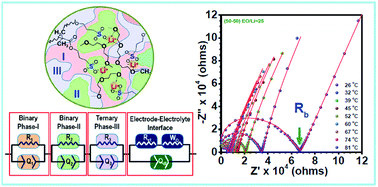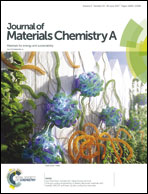Swapping conventional salts with an entrapped lithiated anionic polymer: fast single-ion conduction and electrolyte feasibility in LiFePO4/Li batteries†
Abstract
Herein, we report on a new class of quasi-solid polymer electrolyte matrix that supports appreciably fast single-ion conduction. Showcased as the first example of tailoring a lithiated anionic polymer employing semi-interpenetrating polymer networks approach, the study probes several key factors, such as, (i) polymer–polymer/ion–polymer interactions (ii) phase homogeneity, (iii) effect of oligomeric plasticization, (iv) transition temperatures and thermostability, and (v) H-bonding and degree of crystallinity for a series of binary and ternary compositions, and determines their effect on the overall electrochemical properties. Employing a mutually exclusive reaction strategy, lithiated poly(3-sulfopropyl methacrylate) was synthesized via free-radical polymerization and interpenetrated into a growing polyether-polyurethane network to achieve solid free-standing films. Quantitative cation exchange, polymerization and network incorporation are confirmed by 1H-, 13C-NMR, XRD, ICP-OES, ESI-MS, MALDI-TOF and mid-FTIR. Comprehensive evaluations of physicochemical and electrochemical properties provide crucial understanding of the microscopic contributions of the coexisting phases and correlated charge transport behavior. Unlike the Grotthuss mechanism foreseen for single-ion conduction, interestingly, the findings strongly indicate that charge transport is preferentially promoted within the ether cages that act as ion channels. Impressively, ionic conductivity, σ ≅ 10−5–10−4 S cm−1 with an estimated cationic transport number, tLi+ > 0.87 at ambient temperatures and electrochemical stability >4.7 V could be achieved with composition optimization, which is almost an order more than the documented reports on single-ion conductors. A feasibility study on a LiFePO4/SIC-PE/Li system underscores their potential viability with encouraging preliminary results.



 Please wait while we load your content...
Please wait while we load your content...